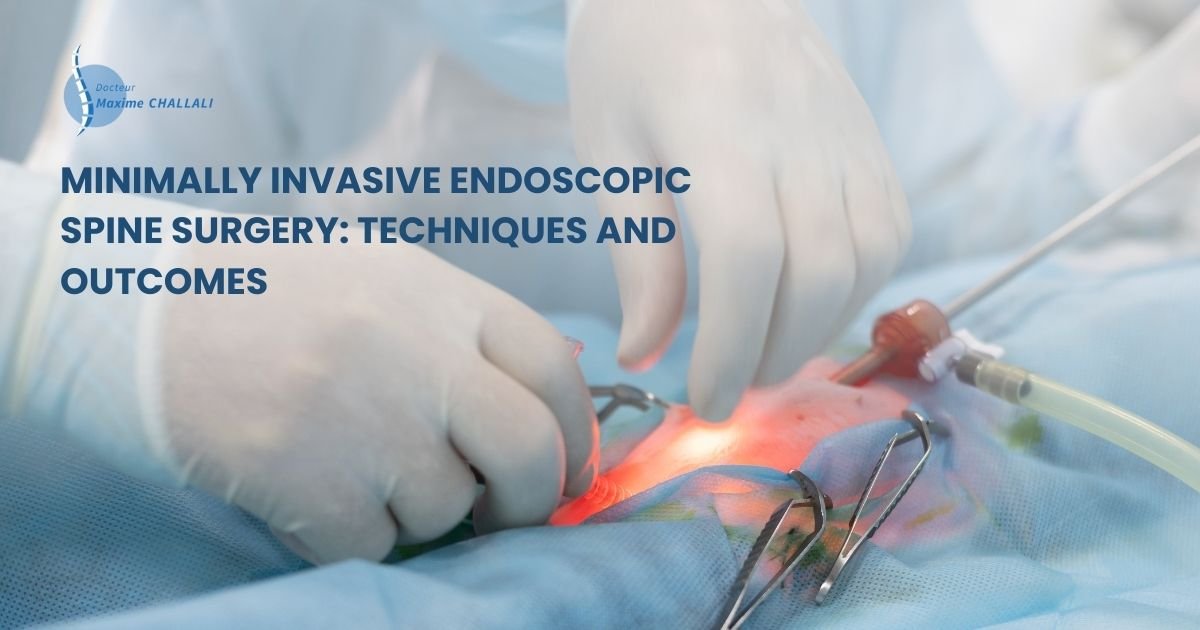Low back pain is among the most frequent issues people face around the globe and is considered one of the main causes of reduced quality of life. In patients requiring further chronic or severe spinal conditions, surgery may be the only option; however, conventional open spine surgery has its drawbacks, high operating times patients’ recovery, and, especially, postoperative pain.
Luckily, there are new options for surgical treatments such as minimally invasive endoscopic spine surgery (ESS) which can provide solutions not only with fewer complication rates and require less time away from work. Now let us take a closer look at ESS, analyzing the principles of its operation, advantages, as well as, what a patient will have to endure, turning to this revolutionary method of spinal therapy.
What Is Endoscopic Spine Surgery?
Laparoscopic spine surgery (LSS) is a technique that requires newer instruments and image intensifiers to operate on spine disorders through minimal access. In other words, ESS fundamentally involves the use of an endoscope which is a flexible, thin instrument fitted with a high-definition camera and light. There is no need to make large incisions or to unfortunately cut many muscles as well as other tissues around them because the endoscope makes it easier for the surgeons to be able to ‘see’ and ‘ eradicate’ the problematic area.
This method is inherent in the group of minimally invasive spine surgery that uses minimal interference with the patient’s body and emotions to achieve the same effects as traditional surgery. Compared to open surgery, ESS is less invasive, results in less scarring, and requires less tissue inflamed; this has made ESS more preferred by many spinal-related cases patients.
Why Endoscopic Spine Surgery Is a Game-Changer
1. Precision and Visualisation
An endoscopic view of the affected region is significantly enlarged and given with high resolution, so it is useful for surgeons. This makes it possible for them to address spinal-related complications perfectly with minimal harm to other tissues within the area.
2. Minimal Tissue Disruption
Conventional anterior procedures to treat back pathologies involve the dissection of multiple layers of muscles and fascia to expose the spine. For the same reason, ESS incisions are much smaller than any conventional surgery, being less than one centimeter in length, which results in much less tissue trauma, less postoperative pain, and faster healing.
3. Shorter Recovery Times
Some of the patients avoid surgery due to the knowledge that they will take a long time to fully recover. ESS eliminates this issue because most people can return to doing light tasks for their regular work after several weeks and have a complete recovery period in far less time than is needed for open surgery.
4. Lower Review of Infection and Spot
ESS has been established to be precise more than standard eyelid surgery; it involves fewer incisions to the body tissues to thus become less prone to infections and other complications. It also means that it is especially safe to use on older persons or those with medical complications.
Conditions Treated With Endoscopic Spine Surgery
ESS is effective for a wide range of spinal conditions, including but not limited to:
- Herniated or Bulging Discs: When the spinal discs push out and exert pressure on the nerves that bring about pain, tingling, or weakness.
- Spinal Stenosis: Dear and localized constriction of the spinal canal pinching the nerves which causes pain and impaired movement.
- Degenerative Disc Disease: Spinal disc degeneration that results in long-term pain and irritation around the back.
- Sciatica: Lower back nerve compression that causes discomfort shooting along the sciatic nerve.
- Facet Joint Pain: Inflammation of the small joints of the spine is arthralgia or arthritis which translates to stiffness and severe pain.
- Spinal Tumours (select cases): Some types of benign tumors are treated using minor invasive procedures.
Approaches to Endoscopic Spine Surgery
1. Transforaminal Endoscopic Discectomy (TED)
This is the most widely used ESS technique, particularly in treating herniated discs.
How it works: A puncture is carried out beneath the affected vertebra and the endoscopic surgery enters the intervertebral space through the foramen. The formidable disc material is subsequently trimmed using appropriate instruments which decreases the pressure on the spinal nerves.
Ideal for: Disc herniations producing nerve root compression or sciatica in patients.
2. Arthroscopic Surgery
It is especially applied the lower back disorders.
How it works: The endoscope is used through the natural interlaminar space between two vertebrae to gain direct access to the spinal canal. In some cases of stenosis, disc herniations, and such, the surgeons do not have to start slicing through the muscle.
Ideal for: Governor and to relieve iatrogenic lumbar stenosis and disc herniations near the spinal canal.
3. Endoscopic Rhizotomy
Developed for patients who have chronic back pain arising from inflammation or irritation of the facet joints.
How it works: By using the endoscopic method the specific nerve roots responsible for the pain are identified and can be treated through radio frequency coagulation or by cutting them to stop sending pain signals.
Ideal for: Those individuals who have severe facet joint arthritis or have chronic lower back pain problems.
4. The Percutaneous Endoscopic Lumbar Discectomy (PELD)
This approach is often used in degenerative disc disease and other conditions involving the discs.
How it works: With a minimally invasive surgical technique, an endoscopic approach is adopted to allow visualization and removal of the pathologic disc material with improvement in spinal stability and pain relief.
Ideal for: Disc-related complaints of both a mechanical and neuropathic nature, as well as problems with frequently performed movements.
What to Expect During and After Endoscopic Spine Surgery
The Procedure
- Anesthesia: ESS is typically done under local anesthetic and the patient may also be given sedation to minimize complications arising from general anesthesia.
- Duration: The duration of the majority of procedures is 1-2 hours depending on the intensity of the disease.
- Minimally Invasive Tools: It enables the surgeon to work through a small incision and with considerable dexterity as he manipulates the endoscope and micro-instruments.
Recovery and Rehabilitation
Rehabilitation is perhaps the most effective area where ESS stands to gain significantly since patients are normally most vulnerable during the post-surgery period. Here’s what you can expect:
- Day of Surgery: The majority of patients are either dismissed right back home or have a full 24 24-hour stay at most hospitals.
- Pain Management: Some people experience mild to moderate soreness, the treatment of which is easily possible through the use of simple pain relievers.
- Return to Activities: The individually moderate loads can be performed within two to four weeks, and the complete healing is received within six to eight weeks.
- Rehabilitation: Man sitting down and exercising A doctor may suggest physical therapy to help maintain back muscle and avoid future problems.
Success Rates and Outcomes
The results of ESS are surprisingly positive as the majority of the trials described at least 90% effectiveness in the treatment of some conditions, such as herniated discs and spinal stenosis. People talk of enhanced pain reduction, flexibility, and overall well-being among patients.
Key Benefits:
- Reduced Postoperative Pain: ESS does not have a very invasive effect on the tissues and therefore minimizes the feeling of pain while healing.
- Improved Functionality: Some patients even can perform activities of daily living without problems.
- Long-Term Relief: As a result, when supported by lifestyle changes and appropriate rehabilitation, ESS has realistic approaches for patients suffering from chronic back pain.
Is Endoscopic Spine Surgery the Right Option for You?
ESS is beneficial in many ways, yet, it is for everyone. Patients with spinal instabilities, infections, or other diseases that may require spinal fusion would require other types of treatment. Spine doctor consultation is recommended particularly if one is seeking to find the most suitable treatment for his or her spine problems.
Conclusion
Endoscopic spine surgery (ESS) is a new method that is safer and quicker than the conventional method. ESS brings greater patient capacity to bear on life than invasive surgery, shorter rehabilitation periods, and better results, and it gives patients back their lives with little more than a sigh.
If you have decided that minimally invasive spine surgery is for you, it is high time that you make the first move toward living a pain-free life. Contact Dr. Maxime Challali, an expert in advanced spine surgery techniques. Speak to us today to find out how the innovative approaches to spinal treatments will help improve your quality of life.

